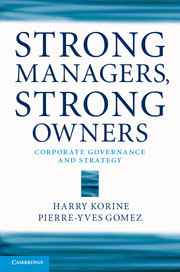Book contents
Part II - Changes in the form of ownership and organization
Published online by Cambridge University Press: 05 December 2013
Summary
In Part I, we explained how the identity of shareholders and managers affects the choice of strategy. We noted that shareholders and managers differ among themselves according to their values and methods. This means that the balance of power between shareholders and managers is more complex than described by agency theory. Rather than a simple opposition between the interests of shareholders and managers, there are in fact a variety of different shareholder and manager interests to consider in thinking through how the identity of shareholders and managers affects strategy. Our approach takes these differences into account and provides a clear framework for analyzing the variety of identities observed in business practice.
And yet, this is only a part of the story. There are many different constellations of the balance of power, and these do not depend solely on the identity of the shareholders and the managers. The context plays a critical role, determining to what extent different shareholders and different managers are substitutable without serious consequences to the i rm. For example, a historical majority shareholder in a family firm cannot be replaced without engendering a profound change in the culture of the firm. Analogously, in a firm that is built around a highly centralized hierarchy, the executive cannot be replaced without serious repercussions for the firm. A priori, one cannot determine if the influence of a shareholder or a manager that is very difficult to replace is positive or negative, in performance terms. What can be said with certainty, however, is that the harder it is, from a structural point of view, to replace a shareholder or a manager, the greater the weight of that shareholder or manager in the balance of power that defines the governance of the firm.
- Type
- Chapter
- Information
- Strong Managers, Strong OwnersCorporate Governance and Strategy, pp. 61 - 64Publisher: Cambridge University PressPrint publication year: 2013



